Daily Global Market Outlook
What's Fair Value for S&P 500, MDG?
25 March 2003
a currency & gold market analysis
by Ed Bugos
| Print Copy | ||
| Today's Highlights: | ||
| We're so bullish on gold it's sickening |  |
|
| Strong economy is source of military might, not other way around | ||
| Why the S&P 500 is going to 600 this year | ||
| Richard Grasso, the croupier | ||
| Meridian could be a buy for aggressive players | ||
| Week ahead | ||
| War premium reinflated Monday, but can it shrink further... | ||
I hope nobody ever surveys our front page in order to assess gold sector sentiment.
We're simply bullish. We've been as bullish on gold through each correction as during each buying spike. If anything, we get margially less bullish on each gain, and marginally more bullish on each decline. We're not one of those analysts that get too bullish when momentum comes in, and then waver in our conviction every time the market does. We're just plain bullish. So all the articles will be bullish until we're bearish.
I know some guys; they'll be sitting on the fence when nothing's happening; screaming buy the hell out of the market when everyone's already come in; and have an articulate case for new bear market lows after the market's finally shaken them out at the bottom.
You probably know some of them too. Well, if you don't know who the sucker is, maybe it's you, as the old poker maxim goes.
Bullish, bullish, bullish I tell you. What's Andy Smith saying now? Not that I mean to imply...
One analyst not wavering in his conviction is Bob Prechter. He's just bearish, on everything I think, except for the dollar. Another is Richard Russell. Russell is holding onto his non contradicting bearish conviction on the Dow and bullish conviction on gold. He said in his letter this week that gold stocks should continue to be accumulated, despite the near term volatility.
I'm afraid folks, drum roll please... we still agree. What a wild ride we're on though, in every way. You can go along doing what you always do, and one day, you wake up in the middle of a mad crowd. It felt that way in 1999 for instance. Hah, I bet you all thought I was going to mention the war...
I agreed with Ari Fleicsher's (White House Press Secretary) comments on the economy today. He said that a strong military is the product of a strong economy. The problem is that some of the bozos running the show in Washington today think it's the other way around - that a strong military produces a strong economy. Wrong, but don't tell them that - even if it's helpful. Don't mention the war...
I grew up loving America, and I still do of course, though I'm Canadian. My parents fleed from Czechoslovakia during the Soviet occupation in the sixties, as many others did at the time.
Although both of my parents understand the pitfalls of socialism on the surface they frequently slip back into the grooves of collectivism. It was in their upbringing you see. And they never had the benefit of a libertarian education, because it wasn't a free country. Accordingly, at least one of them still sees capitalism, rather than government, as the necessary evil. Bear with me. There is a point to this.
I see basically the same misconceptions permeate all of society today. People routinely attribute all the bad things to capitalism, and all the good things to government. Protesting at world bank forums, for instance, draw headlines denouncing unbridled capitalism, when they should instead denounce the real problem - unbridled inflation and government growth. Very, very few analysts (in the scheme of things) seem to be able to make the connection between corrupt monetary policies and the way they fuel the future growth of government, or of taxes, or of imperialism.
Maybe most simply don't have the courage to notice. Maybe the opportunity lies in turning the other way. Or maybe it's just difficult to see our own corruption. The corruption that permeates the global "economy" today is rooted in the quality of the world's money - the dollar - and the consequence is too much government. Most people at least can see the symptoms of an ailing economy.
Alas, my point. So yes, a strong economy goes hand in hand with a strong military. But what does it mean when the economy is corrupt? I'll let you answer that yourself. But don't hammer us for criticizing the factions of American society that are responsible for the demise of its soul, the free market. We're just looking out for thy neighbor.
Which brings me to another point. If Canada were to mobilize the institutions of private property, limited government, sound monetary doctrine, eliminate its creeping socialism, cut its corporate and income tax rates, and deregulate its aristocracies, it wouldn't have to worry about whether it's going to get any table scraps from America now, or at any time tomorrow. These are the things that Canada should be focusing on - building a strong economy. That's indeed how a country becomes strong. You're right Mr. Fleicsher.
But you don't build a strong economy by rigging interest rate and currency markets, nor do you build one by spending it way out of its means - both public and private. America is a terrific example in many ways, at its core, of how to build a strong country. It's what's on surface that troubles many Americans and her friends today. Nobody seems to care about tomorrow.
S&P 500 to Target 600 in 2003 -
Rising Yields & Inflation Expectations
Monday began with sharp reversals in bullish stock market momentum. German
and French markets fell 6% in Europe. The Nasdaq averages finished off
4% in US trading. The Dow closed down 307 points, or almost 4%. In most
cases, the bulls essentially gave back Thursday's and Friday's gains.
The volatility continues.
In terms of the Dow, it was the biggest one day slide all year according to Reuters, but it comes after a 1100 point rally stretching over eight days - all of them gains. So the bulls are still comfortable, since it's just natural for the market to pull back like this.
 The
problems we see are there is too much bullish complacency in this bear
market yet; the rally failed at an important resistance point without
reversing any intermediate (bearish) trends; and markets have all been
overly focused on short term developments, such as which way the war is
going to go, or what's the Fed going to do, or what have you - us included.
The
problems we see are there is too much bullish complacency in this bear
market yet; the rally failed at an important resistance point without
reversing any intermediate (bearish) trends; and markets have all been
overly focused on short term developments, such as which way the war is
going to go, or what's the Fed going to do, or what have you - us included.
The PE ratio (green line in chart) for the S&P 500 was driven back up above 30, after a miserable fourth quarter report in total reported net income. The blue columns in the chart represent S&P 500 reported earnings per share during the latest (trailing) 12 months - ending in December 2002. They're sort of like a moving average of the latest four quarters. The main thing I want to point out is the pattern of estimates into the future. They're still very bullish. The main value earnings estimates have for us at this phase in the bear market is in measuring bullish sentiment.
Analysts polled by Reuters and First Call expect earnings to come back strongly in 2003, again. And in light of the drop in fourth quarter 2002 net income, it would result in an easy comparison by the time the fourth quarter came around next year... just in time for the Presidential election cycle? Surely a coincidence. Really, it probably is.
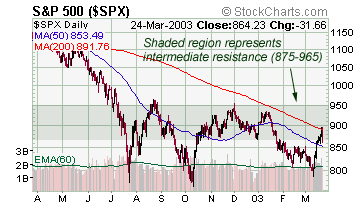 In
fact, it's a convenient coincidence. The bulls don't even need a recovery
as strong as that anticipated in the chart above to dazzle the papparazzi.
Almost any number would beat the $2.43 in reported GAAP income earned
by the S&P 500 index during the fourth quarter. Yes, we definitely
include the extraordinary items, since they seemed to count to
justify valuations during the bull market past - and then some. Or if
not that, at least because I think many companies have extraordinary items
so regularly that it simply should count.
In
fact, it's a convenient coincidence. The bulls don't even need a recovery
as strong as that anticipated in the chart above to dazzle the papparazzi.
Almost any number would beat the $2.43 in reported GAAP income earned
by the S&P 500 index during the fourth quarter. Yes, we definitely
include the extraordinary items, since they seemed to count to
justify valuations during the bull market past - and then some. Or if
not that, at least because I think many companies have extraordinary items
so regularly that it simply should count.
Anyway, it isn't my main point, but it occurred to me just as I was writing how excitable the headlines might read on that happy occasion late next year. Unfortunately, the bulls have been expecting the same recovery in earnings all the way down (i.e. since 2000). It feels like de-ja-vu when I write, 'analysts expect earnings for next year to grow by 67%.' It's the same figure they've bandied about since the "V" recovery theory came into existence almost three years ago now. First 9-11 prevented it, then this war in Iraq did - according to the bullish camp.
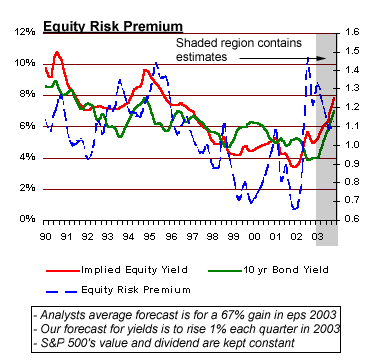 But
when you combine the actions of the Fed, media community, investment community,
indications of bullish sentiment implicit in earnings forecasts and other
indicators, along with convenient excuses in place of poor fundamentals,
what you have is a bunch of bulls in denial about a bear market.
But
when you combine the actions of the Fed, media community, investment community,
indications of bullish sentiment implicit in earnings forecasts and other
indicators, along with convenient excuses in place of poor fundamentals,
what you have is a bunch of bulls in denial about a bear market.
Just about perfect. All you need now is for them to see the inflation.
Just for fun, we matched the bull's estimates for earnings by assuming that bond yields would also rise by 67% this year - to about 7% by the end of the fourth quarter. I think that makes sense in light of such a bullish earnings recovery, don't you think?
In any event, assuming no change in dividends or stock prices, the equity risk premium would contract, as you can see in the chart (blue dotted line). But under circumstances where bond yields and earnings rise to such extent, two entirely opposite things could actually be happening to affect it: 1) stock prices could be booming, which could sustain the dollar, or phony earnings gains, or 2) commodity prices are booming and supporting phony earnings gains. Phony = Nominal in this example.
I don't think there are any other ways to explain rising earnings and interest rates in terms of those variables. At any rate, scenario one describes a disinflationary boom and scenario two describes an inflationary boom.
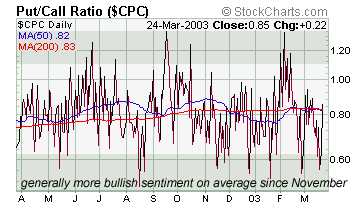 The
significance is that if we assume we are going to have an inflationary
boom, for instance, the equity risk premium should stay near the high
end of its long term range, and vice versa. Of course, there are other
factors that play into the composition of the ERP. The inflation environment
is only one influence, or at least according to the historical record
it is. Productivity is another. But the productivity factor has been overly
discounted if anything.
The
significance is that if we assume we are going to have an inflationary
boom, for instance, the equity risk premium should stay near the high
end of its long term range, and vice versa. Of course, there are other
factors that play into the composition of the ERP. The inflation environment
is only one influence, or at least according to the historical record
it is. Productivity is another. But the productivity factor has been overly
discounted if anything.
So if our outlook is for a weak dollar to sustain the inflation argument - on account of our view that the bear market in stocks has yet to completely run its course - then we are picking scenario number two, and fixing a the equity risk premium at the high end of its range - in order to estimate our target for the S&P 500 this year. We don't need to go back more than ten years. That ought to be sufficient to justify a reference range for this number, since we don't want to throw the productivity argument entirely out.
So instead of keeping stock prices constant to calculate the equity risk premium (the difference between stock and bond yields; since equities contain more risk than a Treasury, it is unusual for stock yields to maintain a discount to bond yields for as long as they did between 1998 right up until late last year), we're estimating an appropriate ERP in an inflationary environment, and fixing it to guess what level the S&P 500 would trade at under the earnings/yield assumptions in the charts above.
Let's arbitrarily pick 1.3 as a fair expectation for the ERP one year from today. That means the implied yield on stocks (dividend + earnings) exceeds the yield on the 10 year Treasury by 30%. It's not really arbitrary though. The 1993 to 1995 period were marked by dollar weakness and mild inflation trends. It's probably conservative, since we expect the inflation to be severe.
Nonetheless, if we expect bond yields to be at 7% by the end of 2003, then the stock yield would have to be 9.1% - fixing the ERP at 1.3 that is. Since we've also fixed the dividend yield at 1.8%, that means we expect earnings to represent about 7.3% of that 9.1% yield. The aforementioned forecasts call for earnings to come in at about $52 for the S&P 500 in 2003. Solving for X, that would put the S&P index at about 712.
I'm going through this so that when you see how we came to a 600 target, and you don't agree, you can at least consider the factors that went into our estimation. They're important even on their own.
If we solved for a range of between 1 and 1.5 for the equity risk premium in the same way, we would come up with a value of between 600 and 1000 for the S&P 500 - that's assuming earnings and bond yields both rise according to forecasts (by about 67% each in 2003 in this case), and dividends remain fixed. We're only varying the inflation outlook - in its impact on the ERP specifically.
However, like I said, I think the evidence suggests that the bulls are continuing a state of denial about the ongoing bear market on Wall Street. So we believe the earnings outlook symptomatic, and is going to be subject to revision as it has in each of the past two years - down. And we believe the inflation outlook is about to get vindication in the market place.
Thus, we would put the ERP above 1.3 on average - over the next two years at least - "and" deflate the earnings forecasts to reflect just a 25% gain on the year, which is still better than anything the bulls have seen since 1999.
Assuming yields still rise to 7%, to validate our weak dollar / inflation outlook, it implies a 463 target level for the S&P 500 despite a decent recovery in earnings. Suffice it to say, in our call for 600, we're giving the bulls some room to bump profits up a little more than we expect, and/or us some room to be a little early on the inflation argument.
Since July, the S&P 500 has been trading in the 750 to 950 range, which as you now know is the upper end of the range outlined in the initial range above (600 to 1000). It doesn't take a genius to figure out the risk/reward ratio from there, but I'll help just in case it's early.
If the bulls are right about the bottom line and continued disinflation, according to our analysis, the S&P could rise to between 1000 and 1200 depending on how high yields go. Disinflation would imply "some" relief on interest rates, but the bull in stock prices would offset it. Still, the 1200 high end of that range includes an assumption for a rise in bond yields to only 5.65%, rather than 7% as we expect regardless of the scenario.
On the other hand, if we are right about the bottom line, and higher inflation, the S&P could fall to between 400 and 600 by the year end.
Thus, from 865, let's see, the potential for a 40% reward compared to the potential for a more than 50% loss. Geez, unless the 67% recovery in earnings this year is a near certainty, I'd say investors would be better off in a T-bill, though even that might be a losing proposition if we're right about our inflation outlook.
Our target (most likely) for the S&P 500 index this year is 600.
| The New York Stock Exchange
said on Sunday that Citigroup Inc. |
In The News
Don't miss the news in the text box to the right. Interesting times. The
house is losing indeed, and I suppose we could assume Grasso's the croupier
if the NYSE is the house's main casino.
I suppose too it's poetic justice. After all, the NYSE is a self regulated exchange made up of its owners who buy their seats; it's not a government elected body.
Spitzer should have no business there. But he does, because Sanford and sons' organization brought the public in and hung 'em high - not just on stocks, but also the dollar. Mr. Weill has nobody to blame for the outcome but himself and his partners in the counterfeiting business. What else can we say?
Meridian Gold released the results of a "non-binding" referendum today in Argentina.
The company said that the referendum was mandatory, but that only 75% of the population showed up. 80% of that sample voted no on Esquel - the property in dispute. But management said it was disappointed that the water study wasn't completed before the event, and that non government environmental organizations such as Greenpeace have become involved in persuading the masses to vote the project down.
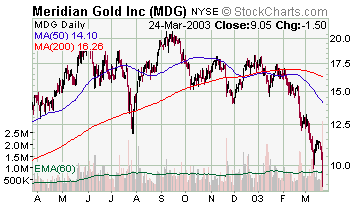 Nonetheless,
the water (environmental impact) study is due by mid April, and a public
hearing is supposed to be held at least 30 days from its completion, according
to press reports.
Nonetheless,
the water (environmental impact) study is due by mid April, and a public
hearing is supposed to be held at least 30 days from its completion, according
to press reports.
There were too many uncertainties, and investors threw in the towel. The stock was down 15% on Monday. In New York it closed at $9.05 per share, which is less than half its 2002 high.
Brian Kennedy, the company's CEO said the campaign against the mine was was based on "negative false information disseminated to the local community by organizations opposed to mining." Mr. Kennedy is sure of his case, and openly expressed his wish to open a dialogue with the residents of the community of Esquel on the true benefits and environmental safeguards of the project.
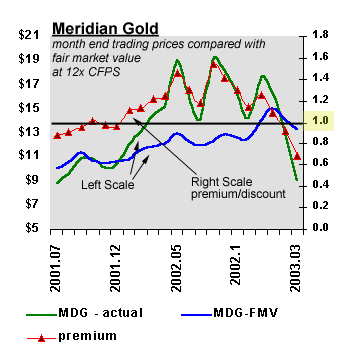 Well,
we agree with the market, and prefer not to speculate about whether the
company is likely to succeed or fail in getting Esquel approved / into
production. But I'd be willing to say that the market has almost entirely
written off the project at this point.
Well,
we agree with the market, and prefer not to speculate about whether the
company is likely to succeed or fail in getting Esquel approved / into
production. But I'd be willing to say that the market has almost entirely
written off the project at this point.
Meridian has about $1.25 per share in free cash on hand, and the cash flow its operations can achieve without Esquel are worth - in equity - between $8 per share (8 times CFPS) and $15 per share (15 times CFPS) at a $332 gold price.
So relative to its current cash flow potential, the stock is trading at the low end of its fair market valuation range, and investors are basically getting to bet on Esquel for free.
Still, I count three negatives.
For one, it has a lower cash cost of production than Goldcorp, which means its cashflow is increasingly less sensitive to further gains in gold prices than most of its other peers, in percentage terms. In other words the stock offers less leverage to the price of gold than the others in our portfolio.
Secondly, most of its production comes from its Chilean mine, El Penon. We attach a relatively higher risk premium to producers with minimal North American exposure, or in other words, to producers where we judge there to be more relative political risk. In a world of falling dollar values, politics get tricky. We prefer to be globally diversified, but weighted in North American gold producers.
Thirdly, the loss of Esquel would put a big dent in Meridian's global reserves. The company has a little over 2 million ounces in reserves (proven and probable) without Esquel - 85% of it comes from El Penon (Chile). The Esquel project promised to add another 3 million ounces. Investors began to factor those reserves and attendant production last year before environmentalist groups began to lobby against the project. This chart doesn't include Esquel's reserves.
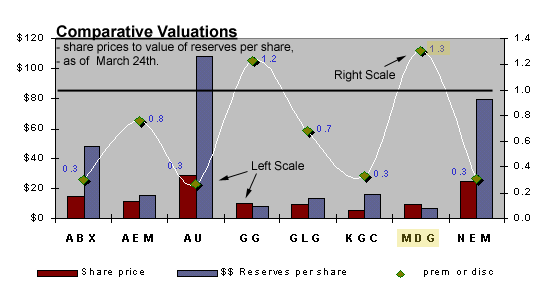
Esquel valuations could have been largely wrung out now, but there is still some excess I think in terms of our three objections above.
As a proportion of reserves per share, Meridian's shares are more expensive than Goldcorp's shares. This shouldn't be too surprising, due to its relatively higher margins. The producers able to achieve the fullest valuations over the course of the bull market in gold to date have been those with lower cash operating costs per share. The fact that we expect this to change - i.e. toward a more equal valuation distribution between low cost and high cost producers - is another reason to be cautious with respect to bottom fishing this particular stock, in my view.
Nonetheless, the current stock price is the best value it's traded at in a long time - relative to gold prices - and the downside couldn't be more than another $2 provided the price of gold doesn't sink more than we expect, and provided nothing unexpected happens to its operation in Chile.
We like this stock for aggressive accounts that already have a large weighting of gold producers in less politically volatile backwaters than South America (no offense to our S.A. clients meant here), and are seeking special situations to add.
Investing in producers with mostly foreign exposure is lucrative, but has to be approached through a proper diversification of alpha (company specific) risk.
At any rate, the upside in Meridian's shares is obvious. Higher gold prices, the company wins approval of Esquel, or it acquires North American reserves/production.
In fact, we're going to consider adding it to our portfolio this week, particularly if it gets weaker. Ultimately, we're going to have 10 stocks in the BGI, and my hope is there won't be any hedgers in the end. Newmont and Anglo wouldn't even be in the index if we didn't think their hedges are destined for liquidation.
The Week Ahead
The week is light to medium on economic news.
February US existing home sales are expected to drop 5% after growing by 8% between December and January when they're released Tuesday.
On Wednesday, the United States announces its durable goods number for February, which too is expected to fall 2% after gaining 2.9% in January. New home sales figures, also due out Wednesday, are expected to rise slightly. The ECB announces January's balance of payments figures, and weekly numbers for mortgage applications and oil & gas inventories in the United States are due as well.
Thursday, another estimate of fourth quarter US GDP is made, followed by jobless claims and some less significant data. On Friday, France and Japan release employment data, while the US releases February personal income data.
Wall Street confessionals about the upcoming first quarter earnings season should begin to kick in soon, and result in the first batch of lowered Q1 earnings outlooks. We're just guessing, but also, going with the trend in both earnings and economic indications.
The gold sector wasn't quite as strong as gold bulls would have liked to see on Monday in light of events. But I think another down day in the Dow like we witnessed Monday would upend the bullish Dow/USD confidence that resulted from a massive unwinding of the war premium last week.
We continue to feel the worst is behind the gold sector, but I'm not sure all the weak hands have been shaken. It's possible that some held on and only now are considering selling into the first sign of strength. I got that impression watching gold stocks trade on Monday.
Moreover, new buyers might be waiting on the sidelines until the war in Iraq is over, with the anticipation that it will indeed be a rather quick US victory - enabling them to buy gold stocks on the cheap yet, for instance. In this case, they're betting that the war premium hasn't fully unwound yet. And they might be right, but I'll just make two points. Most of it probably already has, and who knows if it will further.
Bullish, bullish, bullish I tell you.